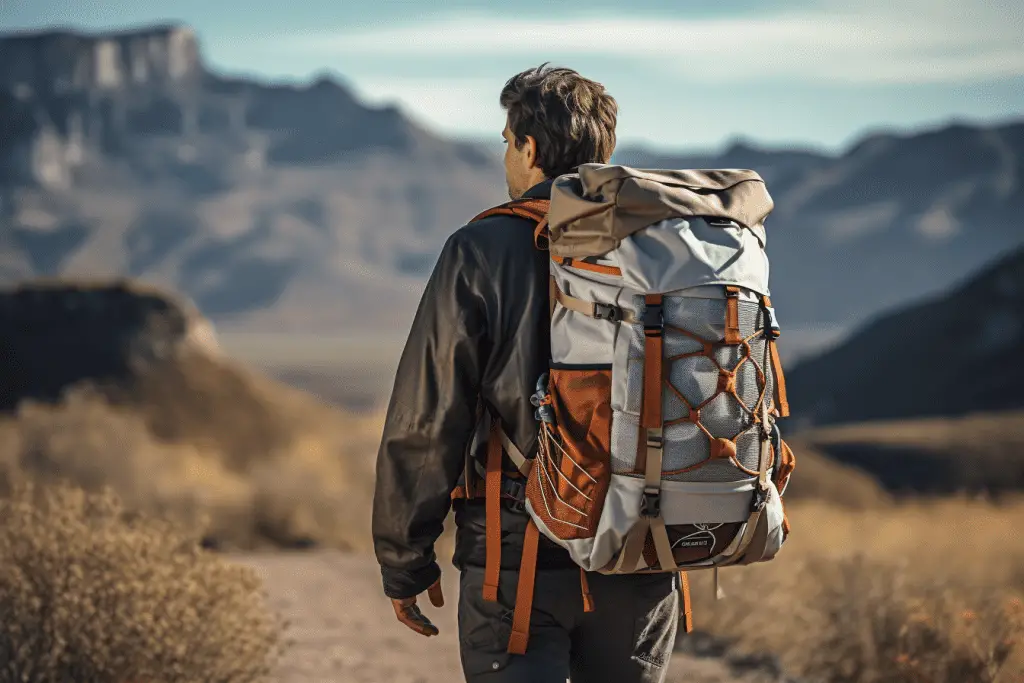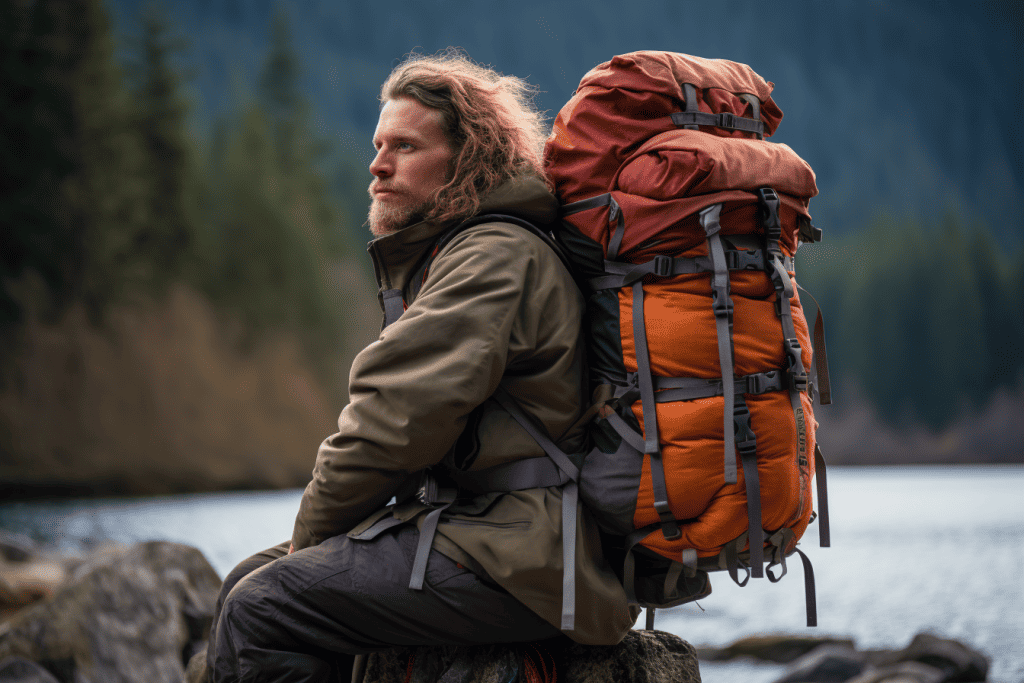Let’s start off by taking a short hike into the world of backpacks, or more specifically, into the realm of backpack frames. You see, all backpacks are not created equal and the skeleton that gives a pack its structure, its frame, can largely dictate its purpose, comfort, and capacity. Now, when we delve into the realm of backpacking gear, a key question often pops up: internal vs external frame backpacks, which one’s the top choice?
Well, to understand the debate between internal and external frame backpacks, we first need to grasp what these frames are all about. At its most basic, a frame is just that, a structure that gives the backpack its shape and distributes the weight of your gear. However, whether that frame is on the inside (internal) or the outside (external) of the pack can make a world of difference in terms of comfort, stability, and how you pack your gear.

Understanding Internal Frame Backpacks
So, let’s first dive into the world of internal frame backpacks. As the name suggests, these packs have a supporting frame on the inside, usually made from plastic, aluminum, or sometimes even composite material. The main draw of these bags is their sleek and compact design, which makes them less bulky and more form-fitting. This gives you a more natural range of motion, which is great when you’re tackling trickier trails or need to maneuver around obstacles.
One of the main advantages of internal frame backpacks is that they’re designed to hug your body. This close fit helps distribute the weight of your gear across your hips and down your legs, which can help reduce fatigue. Plus, this snug fit keeps your gear stable and prevents it from shifting around as you move. So, if you’re planning on doing a lot of moving or climbing, an internal frame backpack can be a real lifesaver!

But there’s a flip side. The close fit of internal frame backpacks means there’s less airflow between the bag and your back. This can lead to a sweaty back on hot days, which might not be the most comfortable experience. Also, these bags require a bit more planning and skill to pack efficiently, as the space can be a bit tighter than in external frame models.
Overall, internal frame backpacks are all about balance and agility, providing a snug and stable carry that’s ideal for more technical trails and activities. They might take a bit of getting used to, especially when it comes to packing, but they’re a popular choice for a reason!
Here’s a simple table that highlights the key pros and cons of internal frame backpacks:
| Pros | Cons |
|---|---|
| Streamlined design – The sleek design is less likely to snag on branches or other obstacles, making it easier to move through dense vegetation or rough terrain. | Less ventilation – The close fit of the pack against your back can lead to increased sweat and discomfort, especially in hot weather. |
| Weight distribution – Internal frame packs distribute the weight of your gear evenly across your hips and down your legs, reducing fatigue. | Trickier to pack – The compact design can make it more challenging to pack your gear efficiently, and it may take some practice to get it right. |
| Stability – The pack’s close fit to your body keeps your gear stable and prevents it from shifting around, which is especially useful when hiking on uneven or steep terrain. | Less external storage – Internal frame packs typically have less external pockets or places to attach gear, which may limit accessibility to commonly used items. |
| Better balance and agility – Internal frame packs offer a better center of gravity because of their body-hugging design, which can be beneficial when climbing, crossing streams, or negotiating tricky terrain. | Harder to fit bulky items – The design of the internal frame backpack can make it more difficult to carry bulky or awkwardly shaped items. |
Understanding External Frame Backpacks
Alright, now let’s switch gears and talk about external frame backpacks. These are the classics, the old-school style that your grandpa probably used on his backpacking trips. The main difference with these packs is, as the name implies, the frame is on the outside. The frame is usually made of aluminum and it’s this external structure that gives the pack its shape and rigidity.
One major advantage of external frame backpacks is their superior load-carrying capacity. These packs are champs when it comes to handling heavy loads, making them a great option for long trips where you need to carry a lot of gear or food. Plus, their structure allows you to attach items like sleeping pads, sleeping bags, tents, or fishing rods to the outside of the pack, freeing up more internal space and making it easier to organize your gear.

Now, let’s talk ventilation. One common complaint with internal frame backpacks is the lack of airflow between the pack and your back. Well, external-frame backpacks solve that problem. The design creates a natural gap that allows air to circulate, helping to keep you cool and dry, especially in hot weather.
On the flip side, external frame backpacks aren’t as streamlined as their internal frame counterparts. They can be a bit bulkier and less comfortable to carry on technical or off-trail terrain. Plus, the weight isn’t distributed as closely to your body, which can make it feel heavier and potentially throw off your balance. Still, for traditional backpacking on established trails with heavy loads, external frame packs hold their own.
Here’s a simple table that highlights the key pros and cons of internal frame backpacks:
| Pros | Cons |
|---|---|
| Streamlined design – The sleek design is less likely to snag on branches or other obstacles, making it easier to move through dense vegetation or rough terrain. | Less ventilation – The close fit of the pack against your back can lead to increased sweat and discomfort, especially in hot weather. |
| Weight distribution – Internal frame packs distribute the weight of your gear evenly across your hips and down your legs, reducing fatigue. | Trickier to pack – The compact design can make it more challenging to pack your gear efficiently, and it may take some practice to get it right. |
| Stability – The pack’s close fit to your body keeps your gear stable and prevents it from shifting around, which is especially useful when hiking on uneven or steep terrain. | Less external storage – Internal frame packs typically have less external pockets or places to attach gear, which may limit accessibility to commonly used items. |
| Better balance and agility – Internal frame packs offer a better center of gravity because of their body-hugging design, which can be beneficial when climbing, crossing streams, or negotiating tricky terrain. | Harder to fit bulky items – The design of the internal frame backpack can make it more difficult to carry bulky or awkwardly shaped items. |
How to Choose the Right Backpack: Internal vs External Frame Backpacks
Choosing the right backpack can feel a bit like solving a puzzle, but it’s really about balancing your specific needs and preferences. Whether you opt for an internal or external frame backpack, there are a few key factors you’ll want to consider to make sure you end up with a pack that fits like a glove, and not like a pair of uncomfortable shoes.
Trail Terrain
One of the first things to think about when choosing a backpack is the type of terrain you’ll be covering. If your adventures are mainly on well-trodden paths and well-established trails, then an external frame backpack could be a good fit. They’re brilliant for carrying heavier loads, perfect for those multi-day hikes when you need to pack everything but the kitchen sink!
However, if your idea of fun involves more off-beat paths or even veering off the trail completely, you might want to consider an internal frame backpack. This style is designed for agility and comfort when you’re hopping over rocks, scrambling up steep inclines, or navigating dense undergrowth. The close-to-body design could be your best buddy when the going gets rough and tumble.
Backpack Carrying Capacity
Now, let’s talk about carrying capacity. This is all about volume and how much ‘stuff’ your backpack can carry. It’s measured in liters and the right amount of volume really depends on the duration and style of your trips. Day hikes or short, lightweight adventures usually need a pack in the region of 20-30 liters.
On the other hand, if you’re all about the long haul and multi-day expeditions are your thing, then you’ll be looking at needing something in the 50-70 liter range. Remember, external frame packs have a reputation for handling larger loads more comfortably, while internal frame packs tend to be more tailored towards lighter, streamlined carry.
Getting A Good Fit
The fit of your backpack can’t be stressed enough. A well-fitting backpack is like a dream, it hugs your body, balances the load, and lets you hike for miles with a smile on your face. Your pack should fit well on your torso, not too high, not too low, and the weight should be evenly distributed across your hips.
So, before you click that purchase button, grab a tape measure and check out the manufacturer’s sizing charts. Get your torso length and hip size, and make sure your chosen pack is going to fit you like a glove. Trust me, your back will thank you, whether you’re opting for an internal or external frame pack.
Needs and Preferences
Lastly, it’s about understanding your needs and aligning them with your preferences. We all hike in our own way and there’s a backpack out there for everyone. Your choice should reflect the type of trips you’re most likely to embark on, the capacity you need, and of course, how it fits your body.
Remember, it’s not a one-size-fits-all world. The ‘best’ backpack is the one that suits your needs, fits you perfectly, and makes every journey feel like an adventure. So, consider your options carefully, and make your decision count.
The Role of Personal Preference and Specific Needs
In the grand scheme of things, choosing between an internal and external frame backpack is not a one-size-fits-all proposition. It really comes down to your personal preference and specific needs. And what do we mean by personal preference? Well, simply put, it’s about what feels right to you. You might prefer the close-hugging fit of an internal frame pack, or maybe you like the old-school vibe and airy back panel of an external frame backpack. It’s about what feels good on your back, and aligns with your hiking style.
Your specific needs, on the other hand, refer to the practical aspects of your hiking or backpacking trips. Are you planning a multi-day trip in rough terrain? Do you prefer shorter, day-long hikes? Do you need to carry heavy loads or do you practice minimalist backpacking? The answers to these questions will largely dictate the type of backpack that’s best suited for you. For instance, long trips with heavier loads often call for an external frame pack, while an internal frame pack might be more suitable for shorter or more technical hikes.

Comfort is another major factor to consider, as it can greatly impact your overall experience. How a backpack fits and feels on your body can make the difference between an enjoyable hike and a painful trek. This is where trying on different backpacks before making a purchase can be extremely beneficial. If you have the opportunity, head to a local outdoors store and try on a variety of models. Walk around, feel the fit, and even see if they have weighted bags to simulate a loaded backpack.
In the end, the best backpack for you is going to be the one that meets your individual needs and aligns with your personal preferences. The choice between an internal and external frame backpack is a personal one, and what works best for one person may not work best for another. So take your time, do your research, and choose a backpack that feels like the perfect companion for your adventures.
Popular Brands for Internal and External Frame Backpacks
When it comes to outdoor gear, there are certain brands that have stood the test of time, constantly innovating and earning a trusted spot in the hearts of hikers and backpackers. Let’s take a look at some of the popular brands that offer high-quality internal and external frame backpacks.
Internal Frame Backpack Brands
Let’s kick off with some of the heavy hitters in the world of internal frame backpacks. First up, we have Osprey, a brand that hikers and backpackers swear by. They’ve carved a niche for themselves with backpacks that deliver on durability and comfort, and are packed with innovative features designed to make your outdoor adventures smoother. Whatever your needs may be, you’re likely to find an Osprey backpack that fits the bill.
Then we have Deuter, another trusted name in the backpacking world. With roots tracing back to Germany and over a century’s worth of experience in making outdoor gear, Deuter knows a thing or two about what makes a great backpack. Renowned for their sturdy construction and ergonomic design, a Deuter pack could be your trusty companion on many a trail. And let’s not forget The North Face. Known for their blend of simplicity, functionality, and style, their backpacks have a certain allure that makes them popular among outdoor enthusiasts.
External Frame Backpack Brands
Switching gears to external frame backpacks, we have a few standout brands to talk about. Let’s start with Kelty, a brand that’s maintained its fondness for the classic external frame style. If you’re carrying a heavy load and need a backpack that’s up to the task, a Kelty might just be your perfect match. They offer models known for their durability, comfort, and impressive load-carrying capacity.
But don’t overlook Alps Mountaineering. This brand is a great option for those looking for budget-friendly external frame backpacks that don’t compromise on quality or comfort. Alps Mountaineering backpacks are solid, dependable, and won’t break the bank. And we can’t talk about external frame packs without mentioning the iconic JanSport. With a line of external frame packs that skillfully combine a retro vibe with modern features, JanSport offers a cool twist to traditional backpacking gear.
Choosing Between Backpack Brands
It’s worth noting that every brand has its own unique features, and it’s important to explore these when choosing a backpack. Look for brands that offer the features you need and prefer, be it pockets and compartments for organization, adjustable and padded straps for comfort, or a hydration reservoir for easy access to water.
So whether you’re a fan of the sleek design of internal frame backpacks or prefer the classic style and load-carrying prowess of external frame packs, these brands have got you covered. Ultimately, the best brand for you is the one that ticks all the boxes for your personal preferences and hiking needs.
Concluding Thoughts: The Best Backpack for Your Next Adventure
As we wrap up this deep dive into internal vs external frame backpacks, it’s important to remember that the best backpack for your next adventure is largely subjective. What works well for one hiker might not work for another, and what suits a multi-day expedition won’t necessarily be the best fit for a short-day hike. So, rather than seeking a definitive answer to which type of backpack is better, focus on finding the right pack for your specific needs, personal comfort, and type of trek.
Internal and external frame backpacks both have their unique strengths and are designed to cater to different types of hiking experiences. Whether you’re drawn to the close-fitting comfort and agility of an internal frame pack, or you prefer the heavy-duty carrying capacity and ventilation of an external frame backpack, both types have plenty to offer. Remember, the journey of finding the perfect backpack for your adventures is just as exciting as the adventures themselves. So take your time, consider your options, and choose a backpack that feels like an extension of your own adventurous spirit. Happy hiking!
